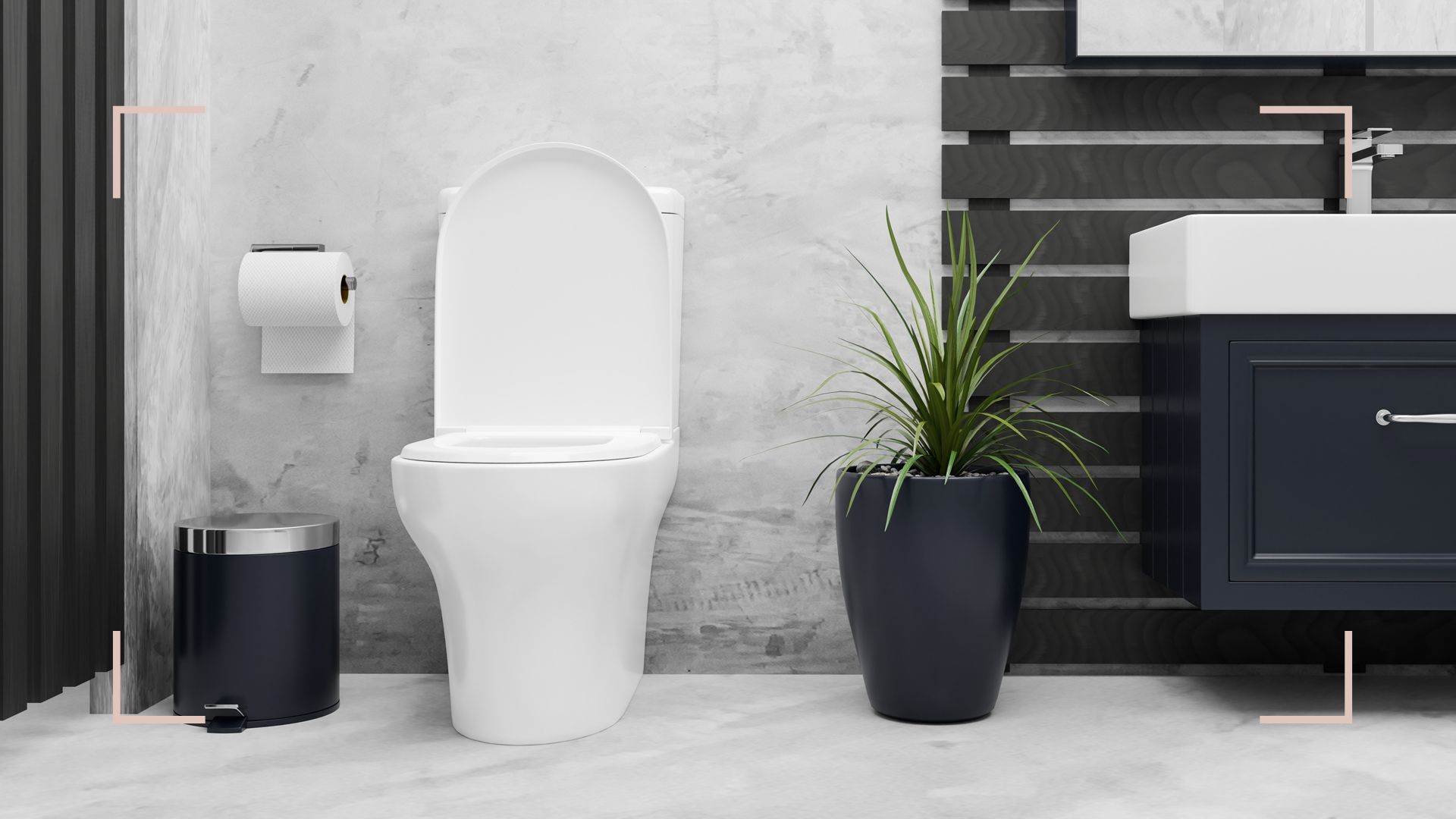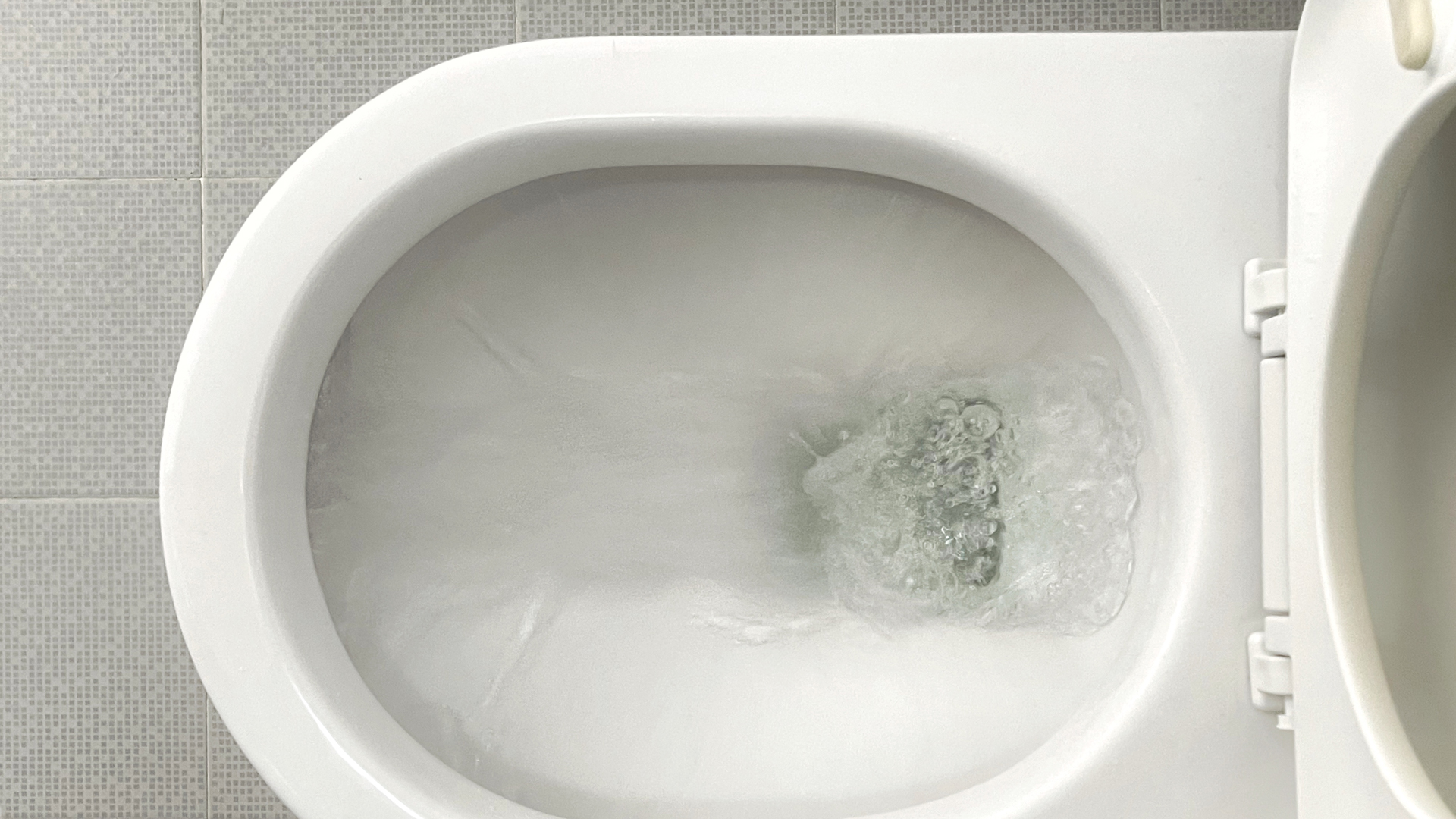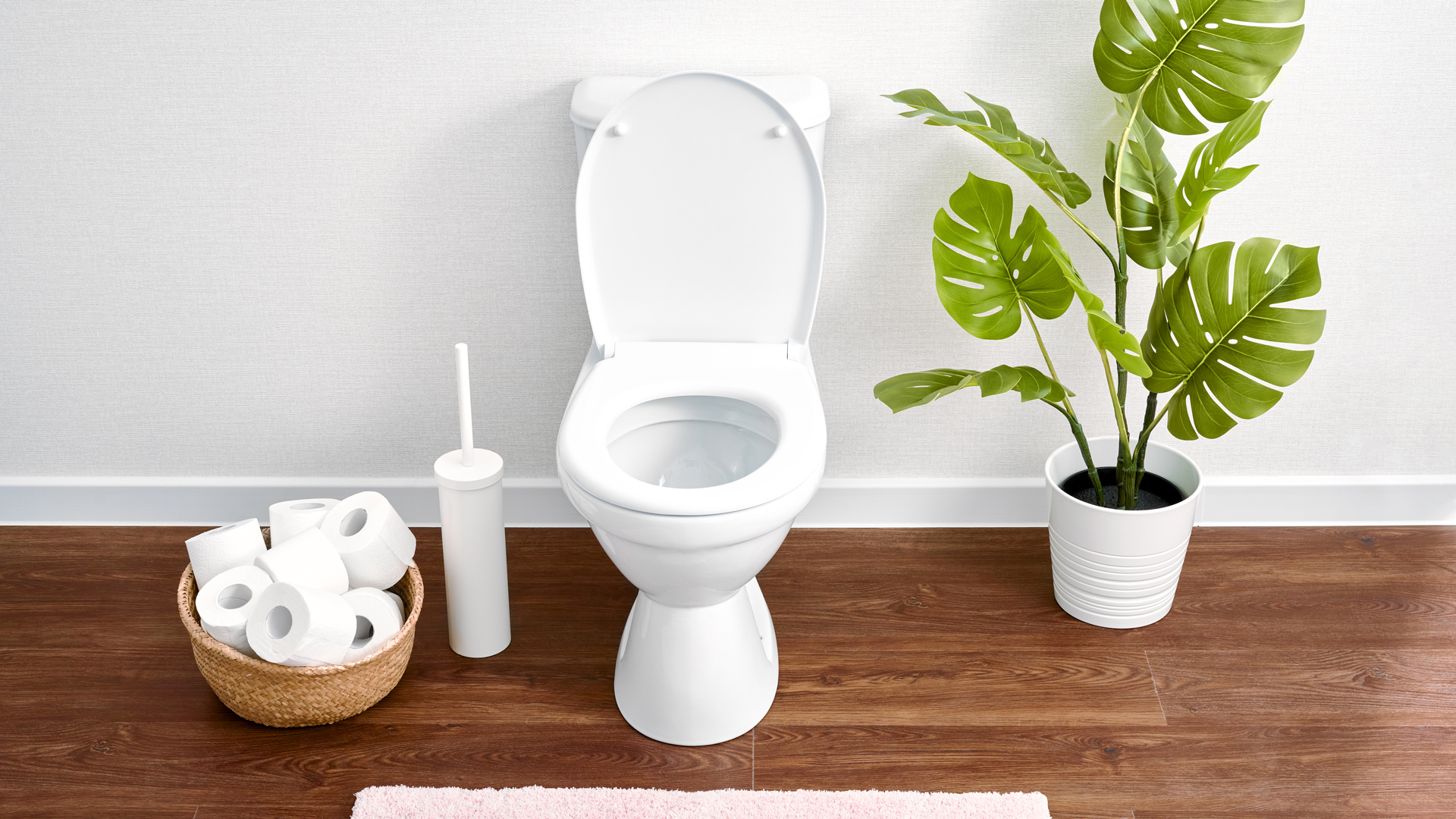How to clean toilet stains effectively without harsh chemicals - in five simple steps
Experts advise on how to clean toilet stains thoroughly for a gleaming toilet using white vinegar, a pumice stone, and other natural ingredients

Cleaning your toilet, and in particular, working out how to clean toilet stains, may be one of the least glamorous parts of adult life, but it's a necessary chore for a clean-looking and hygienic bathroom.
Removing stains from your toilet can be particularly arduous if you've neglected this bathroom cleaning task as hard stains can accumulate and become stubbornly difficult to eliminate. Staining can often happen in areas of the toilet that are hard to reach - or because of hard water issues, meaning they will regularly re-appear even if you regularly clean. All of this is why knowing how to clean a toilet thoroughly is so important.
Making sure your toilet bowl is clean and fresh is an essential step in good home maintenance. After all, staying on top of toilet stains is essential for your health, as giving it a regular scrub reduces the occurrence of harmful germs and bacteria in the bathroom.

How to clean toilet stains fast and effectively in 5 steps
There are five basic steps to cleaning a badly stained toilet to get sparkling results every time. Follow this process in this order, and your toilet will be gleaming in no time.
Before you get started, you'll need to collect some supplies to get the job done.
You will need:
- Cleaning gloves
- Toilet brush
- Pumice or toilet stone
- Toilet bowl cleaner – experts recommend cleaning with vinegar and bicarbonate of soda
- Natural all-purpose spray cleaner
- Cleaning cloth or paper towel
1. Do a quick brush around the bowl
The first step is to use your toilet brush and toilet bowl cleaner to do a quick scrub around the entire inside of the toilet. This does not need to be your best cleaning work – just a quick round or two around the bowl should do it.
Sign up to our free daily email for the latest royal and entertainment news, interesting opinion, expert advice on styling and beauty trends, and no-nonsense guides to the health and wellness questions you want answered.
The primary aim of this step is to give the toilet a surface clean, to get rid of any lingering spots of dirt, before a deep clean. Once this is done, flush the toilet. You will probably see a ring around the bowl where the waterline sits.
2. Lower the water level in the bowl
Do this step if the stain is below the water in your toilet bowl. If it is above the waterline, you can move straight on to step three. Use the toilet brush to push the water through the drain – to do this, just push the toilet brush through the drain with a few forceful shoves or use a plunger. This may take a little time, but you should see the water receding a bit, if not disappear altogether.
This technique temporarily lowers the water in the bowl while you are cleaning—all you need is for the water line to be lower than the stain.
Another way to lower the water, if the above isn't working, is to adjust the float ball in the tank. This is not a temporary change, and if you want to switch it back, you will need to adjust it again after cleaning.
To adjust the float ball in your tank:
- Take off the lid from the tank
- Remove the chain from the float ball
- Reattach the chain at a lower point, shortening it
- Replace the lid on the tank
- Flush the toilet
After the toilet is done flushing, the water line will be lower. If you decide to keep these settings in place, you will save some water, but this could cause stains to be lower and harder to reach the next time you clean the toilet.

3. Use a pumice stone to scrape the bowl
Now you will need to use a white pumice stone, or one that is specifically made for toilets, to begin scrubbing at the stain. Start by rubbing the stone around the stained ring area. The point is to scrape off the hard water residue slowly.
If you have staining under the rim, you will need to repeat these steps there too. While you should be careful and fairly gentle with this step, don't worry too much about harming your toilet – white pumice and toilet stones are generally safe for use on porcelain.
It's important to note here that for really stubborn stains that have been there a while, it could take multiple tries to remove them with scrubbing. It's valuable time spent though as upkeep will be much easier once you've shifted the stains. Plus, you can burn up to 256 calories an hour scrubbing your bathroom, if you're wondering how many calories you can burn with household chores.
4. Scrub away the mess with a toilet brush
The next step is to use the toilet brush and bowl cleaner or your natural cleaning solution, again before flushing. The aim of this is to loosen any dirt and hard water so that it will easily lift off and flush away.
An important thing to note about toilet cleaners – most plumbers recommend staying away from harsh chemical cleaners that may be corrosive, as this could damage the toilet more. Commercial drain cleaners, for example, have been known to crack the porcelain. Instead, go with a cleaning brand you trust, a homemade concoction, or one that is stated to be better for the environment. This will be gentler on your toilet bowl.
We'd recommend using white vinegar and bicarbonate of soda as a homemade cleaning solution, for more details see below.
5. Clean the rest of the toilet
Now that you have removed the staining, it's a good idea to give your toilet a general clean. Starting from the top of the toilet at the tank, begin spraying your disinfecting all-purpose cleaner. We recommend choosing a natural solution to avoid harsh chemicals.
Next, you will use a cloth or toilet paper to wipe clean. Toilet tissue means you can flush away immediately, for a more hygienic option. If you are using a cleaning cloth ensure to follow the steps on how to clean a microfibre cloth after cleaning any area of the toilet to sterilize it.
Don't forget to clean the flusher. Keep spraying the surface as you make your way around the entire toilet. It's wise to wipe the floor under the toilet, too, unless you're planning on mopping afterward.
How do you clean a badly stained toilet bowl?
“The golden rule for cleaning toilet bowl stains is to use non-alkaline products," advises Chris Wootton, Managing Director of the domestic cleaning business, Poppies. "Most toilet bowl stains appear in hard water areas, so it’s important to remember that bleach won’t work, and you will need to use an acid-based product such as limescale remover."
"While bleach doesn’t get rid of limescale, it does make it invisible which blends in with the color of the toilet bowl. That’s why toilet bowl stains appear to come back quickly, as they never actually went away."
To ensure the limescale is gone for good Chris recommends using vinegar, to make your own powerful but natural cleaning solution. Here's how to do it...
How to clean toilet stains with vinegar
Chris' advice is to use a non-alkaline cleaning solution for which he suggests a natural cleaning hack using vinegar, saying: "Making a vigorous acidic solution is best done by using white vinegar. Pour a half cup of bicarbonate of soda into and around the bowl and let it sit for at least 15 minutes."
"Then, apply white vinegar over the baking soda. This produces a fizzing reaction that activates the acid and can break down the most stubborn build-ups of limescale. After about 10 minutes, scrub the toilet bowl thoroughly with a scouring pad – you may need to use some elbow grease!"
"Once you have done this, flush a few times to rinse it all away. This should have done the trick, but if there are any lingering marks, you can also try lemon juice after you flush, as the acidic solution can help lift the most stubborn stains as well as deodorize the toilet bowl.”
How to clean toilet stains without scrubbing
For a natural solution that requires no scrubbing Lynsey Crombie, cleaning expert, TV star, and Queen of Clean offers her advice on how she tackles toilet bowl stains with her homemade solution. "To clean the unsightly brown stains in the toilet, I make up my toilet cleaning powder using citric acid and bicarbonate of soda."
Explaining how she uses the solution Lynsey details, "I use two large scoops of bicarbonate of soda, one large scoop of citric acid, adding some tea tree essential oil as this is antibacterial," she adds. "Mix them all and pour directly down the toilet. Leave for 20 minutes before flushing, and stains are gone." No scrubbing involved.
Lynsey adds, "If you want to use vinegar to get rid of the stains without scrubbing, plunge out some of the water and then add about 250 ml of white vinegar and leave to sit overnight, flush in the morning."

What causes brown stains in a toilet bowl?
Of course, dirt and build-up in our lavatories isn't a surprise, given their primary function. But if you're seeing discolored, unpleasant toilet bowl stains in or around the rim, it's worth knowing that there are three main things likely to cause this.
- Bacterial growth – the moist environment inside the bowl is like heaven to germs, giving them space to spread and flourish. And if the toilet isn't regularly cleaned, the bacteria will cling onto the toilet and begin to stain it.
- Hard water – if you live in a hard water area, it's more likely you'll get stains on your toilet. The quality of your tap water depends entirely on your geographical location, so while this is not something you can control easily, there are ways to mitigate the impact. Hard water causes a crusty residue to form around the rim and in the bowl. This residue holds on to the bacteria and other debris, creating stains. You might find the same is true for your kettle or shower head (you might want to peruse our guides on how to descale a kettle and how to clean a shower head to tackle this).
- Waiting too long between cleanings – regular spot cleans and a weekly deep clean should keep toilet stains at bay.
“Limescale is the result of calcium and magnesium being left behind when hard water evaporates, causing a chalky, scummy residue to build," explains Tony Jones, General Manager at Harvey Water Softeners. "Limescale can take on a host of colors depending on the different compounds that can be found in the water coming into your home – with build-ups usually taking an off-white or grey color."
"Out of all the areas and appliances in our homes, the toilet is one of the most problematic and this is because it sees a lot of use and constantly has still water sitting inside of it, which is the perfect environment for limescale to thrive," says Tony.
"Coloration is further influenced by the fact that, as limescale dries, it picks up any dirt particles along with it and slowly stains build layer by layer on the inside of the toilet bowl."
How to prevent toilet stains in future
After doing a deep clean of your toilet to get rid of stains, you'll likely want to know how to prevent stains from building up in the future. Below are a few tips for preventing toilet bowl stains, to ensure regular upkeep of your loo is simple and quick going forward.
- Clean regularly – cleaning your toilet as often as possible is a good way to prevent stains from building up. A good rule of thumb for regular bathroom cleaning is once a week, as recommended for how often you should vacuum. Designate a bathroom cleaning day, or add it to your chore schedule.
- Flush the toilet – flushing your toilet often will help to give it a quick rinse, thereby reducing the likelihood of stains building up. If you want to save flushes and water though, you might want to consider a dual-flush or low-flow toilet. If that's not in the budget, put a brick in the tank. Doing this will decrease the amount of water needed to refill the tank after each flush without lowering the amount of water in the bowl.
- Manage hard water – if you really want to avoid hard water stains on your toilets and other fixtures, you will need to invest in a water softener. These are not cheap, but they will increase your home's value, increase the life of your fixtures, and help keep your plumbing working efficiently. Another place you will feel the benefit of soft water is on your body – hard water can affect hair and skin too, causing dry skin and weighed-down hair.
Cleaning your toilet may never be your favorite chore, but having a fresh, clean bathroom every day is worth the effort.
And now that you've given your toilet a deep clean, why not turn your attention to other parts of your bathroom? See our guide to how to clean marble, or how to clean grout in your shower or bath. We also have a step-by-step guide to how to clean windows, an often-missed part of our bathroom cleaning routine. The whole room will be sparkling in no time!
Amy Hunt is an experienced digital journalist specialising in homes, interiors and hobbies. She began her career working as the features assistant at woman&home magazine, before moving over to the digital side of the brand where she eventually became the Lifestyle Editor up until January 2022. Amy won the Digital Journalist of the Year award at the AOP Awards in 2019 for her work on womanandhome.com.


